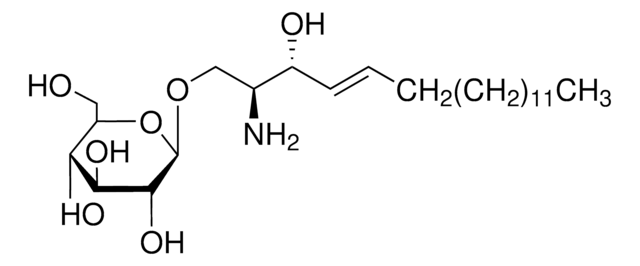860952P
Avanti
Lyso GB3 (synthetic)
powder
Synonym(s):
Globotriaosylsphingosine
About This Item
Recommended Products
Assay
99% (TLC)
form
powder
packaging
package of 1 × 500 μg (860952P-500UG)
manufacturer/tradename
Avanti Research™ - A Croda Brand
lipid type
sphingolipids
shipped in
dry ice
storage temp.
−20°C
SMILES string
O[C@H]1[C@H](OC[C@H](N)[C@H](O)/C=C/CCCCCCCCCCCCC)O[C@H](CO)[C@@H](O[C@@H]2O[C@H](CO)[C@@H]([C@H](O)[C@H]2O)O[C@H]3O[C@H](CO)[C@@H]([C@H](O)[C@H]3O)O)[C@@H]1O
InChI
1S/C36H67NO17/c1-2-3-4-5-6-7-8-9-10-11-12-13-14-15-21(41)20(37)19-49-34-30(47)27(44)32(23(17-39)51-34)54-36-31(48)28(45)33(24(18-40)52-36)53-35-29(46)26(43)25(42)22(16-38)50-35/h14-15,20-36,38-48H,2-13,16-19,37H2,1H3/b15-14+/t20-,21+,22+,23+,24+,25-,26-,2
InChI key
GRGNVOCPFLXGDQ-TWHXEDJUSA-N
General description
Application
Biochem/physiol Actions
Packaging
Legal Information
Storage Class Code
11 - Combustible Solids
WGK
WGK 3
Flash Point(F)
Not applicable
Flash Point(C)
Not applicable
Regulatory Information
Choose from one of the most recent versions:
Certificates of Analysis (COA)
Sorry, we don't have COAs for this product available online at this time.
If you need assistance, please contact Customer Support.
Already Own This Product?
Find documentation for the products that you have recently purchased in the Document Library.
Our team of scientists has experience in all areas of research including Life Science, Material Science, Chemical Synthesis, Chromatography, Analytical and many others.
Contact Technical Service








